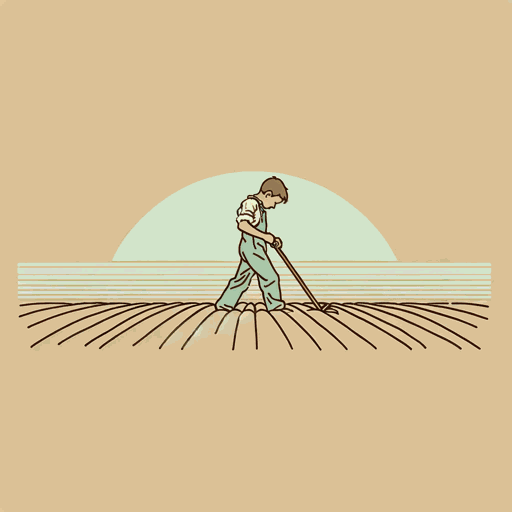57 pages • 1 hour read
Laura Ingalls WilderFarmer Boy
Fiction | Novel | Middle Grade | Published in 1933A modern alternative to SparkNotes and CliffsNotes, SuperSummary offers high-quality Study Guides with detailed chapter summaries and analysis of major themes, characters, and more.
Summary and Study Guide
Overview
Farmer Boy (published in 1933) is a middle-grade historical fiction novel by Laura Ingalls Wilder. The second installment in the Little House series, the book departs from her life to follow Almanzo Wilder, her husband. The story, set in the 1800s, follows nine-year-old Almanzo and his family, who live on a prosperous farm in New York state. Almanzo desperately wants his own horse. As the youngest of four siblings, he knows he’ll have to wait patiently and prove his dedication and maturity through hard work before Father will allow him to train one of their horses. The tale follows Almanzo’s life over more than a year and describes his experience of seasons on the farm and completing various chores, such as milking the cows; planting crops like corn; hauling wood; cutting ice in the winter; training oxen; and preparing food, hay, and other resources. Through many farm lessons, Almanzo finally earns his own horse, a colt named Starlight.
This study guide refers to the 2016 Kindle e-book edition published by HarperCollins.
Plot Summary
Almanzo Wilder, a nine-year-old boy who lives on a large farm in New York state, attends school for the first year. He’s the youngest of four, and his older siblings—Eliza Jane, Royal, and Alice—have already started attending school, but Almanzo never has. They walk through heavy winter snow to the tiny schoolhouse, where Almanzo learns how to read and spell. They only go to school for basic skills a few months a year, since they need to help with chores on the farm. Although his teacher is nice, Almanzo would rather stay home and help Father and Mother on the farm. He’s proud of his family farm and Father because he’s an honest, smart, and hard-working man. Father has the biggest farm in the county, and he’s well-known for his fine horses, oxen, and cows.
Throughout the seasons, Almanzo helps his family sustain themselves. They grow their own crops for food to survive, sell horses and vegetables like potatoes, and preserve and cook food such as jellies, jams, and vegetables in their cellar. The whole family has daily chores, such as feeding the horses, cows, and sheep, milking the cows, churning butter, sewing clothes, cooking, and cleaning. More than anything else, Almanzo wants his own colt (a young male horse), but Father doesn’t think he’s mature enough to train a horse yet. Almanzo works hard to convince Father that he’s ready to have a horse because he’s always gentle, patient, and loving with the farm animals.
On Almanzo’s birthday, he receives a yoke for his two cows, Star and Bright, and learns how to teach them commands to go, stop, and turn left and right. Soon, he trains his cows to pull a bobsled to carry timber for their fireplace and stove. He also trains them to pull a wagon. Almanzo works many hours to teach his calves.
In the winter, Almanzo helps Father and Royal cut ice from the local lake. They cut the ice into squares and store it in their icehouse, using hay to keep it from melting. Almanzo almost falls in the lake, and Father warns him to be more careful. As winter ends, they harvest sap from the trees in the woods to make syrup and sugar that the family uses all year long for baking and cooking. When potato buyers come to town, the whole family gathers their potatoes from the cellar, and Father goes to town and sells them. Likewise, Mother sells her butter when the butter buyer comes. Throughout the year, the family sells different crops, such as hay, or Father sells some of his well-trained four-year-old horses. They take their earnings to the bank. Almanzo learns the value of hard work, since they make money only if they grow good crops and raise good animals.
Every spring, new animals are born, and Almanzo admires them. This year, his attention centers on the adorable colt Starlight, whom he wishes he could have as his own. Spring is also planting time. The family plants various crops, such as potatoes, carrots, grains, and corn. They have little machinery to help, so they do most of the work by hand or with horses, plows, and hoes. In addition, they shear their sheep every spring, using the wool to make clothes like suits, dresses, mittens, and hats. Mother works on her loom for hours after sheep-shearing.
Since the farm runs according to the seasons and weather (for example, crops must be planted in the early spring and harvested in the late fall), the family must adjust their routine to unusual weather conditions. When a cold snap hits, the family must hurry to save crops that could freeze from an early frost. They work from dawn to dusk to save the freezing corn by watering it. In the summer, Almanzo grows a pumpkin for the fall fair, and his family attends the Fourth of July festival. Later, at the country fair festival in the fall, Almanzo earns the winning blue ribbon for his pumpkin, which makes him proud. Father then gives Almanzo a silver dollar, which is a lot of money. He trusts that Almanzo has learned the value of how much work goes into just one dollar on the farm. Almanzo understands and buys a little pig. He names the pig Lucy and plans to sell her piglets.
The family has a pattern of harvesting their crops: One harvest is in the fall, and one is in the early winter. They gather all the crops—from potatoes to carrots—and put them in the cellar for storage. It takes many days to accomplish all these necessary chores, but the harvests provide them with enough food for the year. In addition, they thresh the hay to make hay bales and straw for the animals.
On the way to town to sell the hay with Father, Almanzo sees a pocketbook on the side of the road. It contains $1,500. Father thinks it belongs to Mr. Thompson, whom Almanzo finds in town at the wagon shop. He returns the pocketbook, and Mr. Thompson double-checks to make sure Almanzo didn’t steal anything. Almanzo is insulted that the man thinks he could be a thief. Mr. Paddock, the shop owner, gets so angry about Mr. Thompson being rude to good-hearted Almanzo that he forces him to give Almanzo $200. Afterward, Mr. Paddock explains the situation to Father, who is proud of his son. Mr. Paddock asks if Almanzo wants to become his wagon- and carriage-building apprentice. He knows Almanzo is a good, honest boy who could be a wealthy wagon builder. Father thinks about it.
At home, Father and Mother discuss Almanzo’s future. He could apprentice soon, since he’s 10 now, but being a wagon builder means living in town and relying on others for money. Farming is self-sustainable and provides more freedom. When Almanzo’s parents ask him what he wants to do, he tells them he wants a colt more than anything else. He also wants to be just like his father and have a farm. He chooses to be a farmer boy, not a wagon builder. Father rewards his choice by finally letting him have his own horse: Starlight, Almanzo’s favorite colt in their herd. Almanzo is overjoyed.
Related Titles
By Laura Ingalls Wilder

By the Shores of Silver Lake
Laura Ingalls Wilder

Little House in the Big Woods
Laura Ingalls Wilder

Little House on the Prairie
Laura Ingalls Wilder

Little Town on the Prairie
Laura Ingalls Wilder

On the Banks of Plum Creek
Laura Ingalls Wilder
Featured Collections
Animals in Literature
View Collection
Books on U.S. History
View Collection
Childhood & Youth
View Collection
Coming-of-Age Journeys
View Collection
Community
View Collection
Family
View Collection
Good & Evil
View Collection
Juvenile Literature
View Collection
Religion & Spirituality
View Collection
Science & Nature
View Collection

